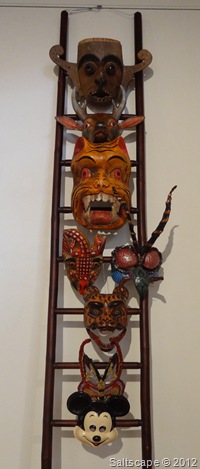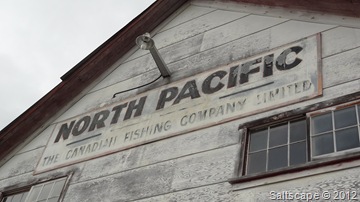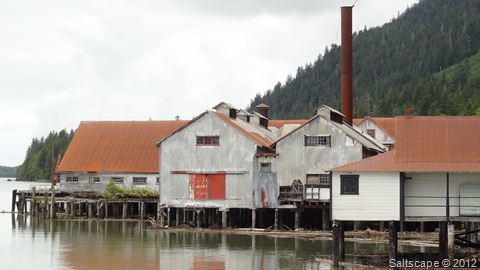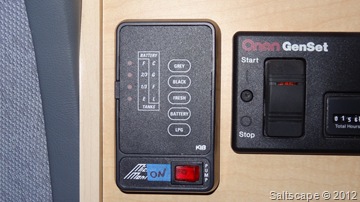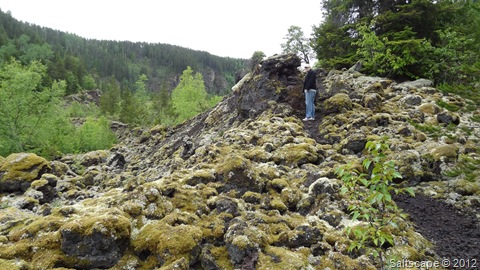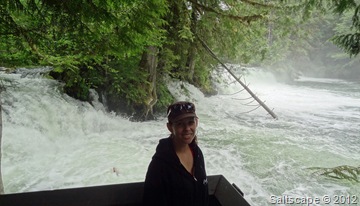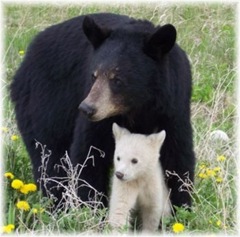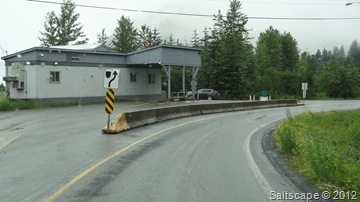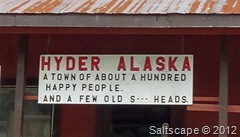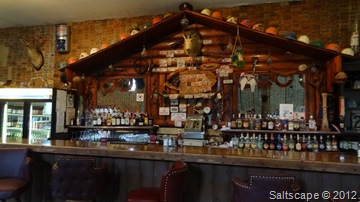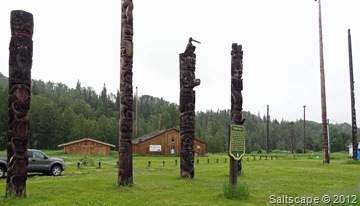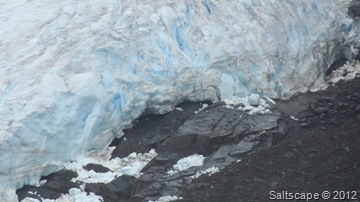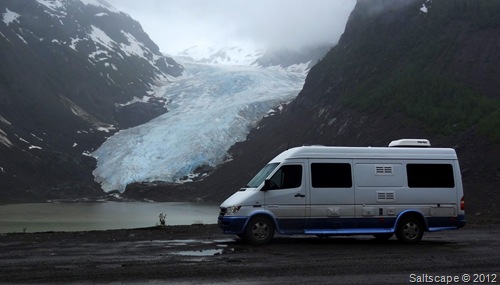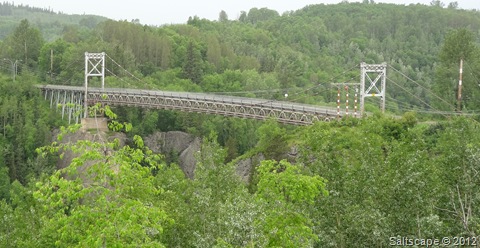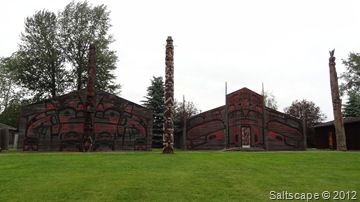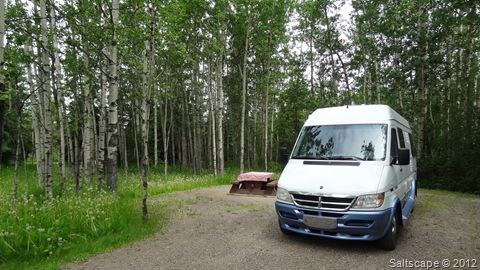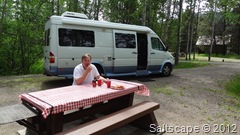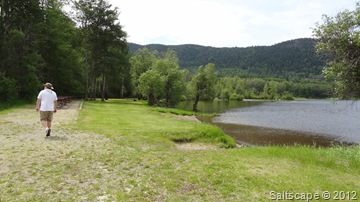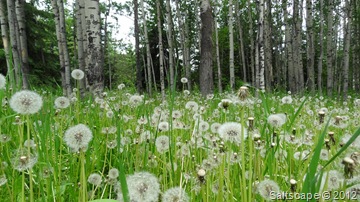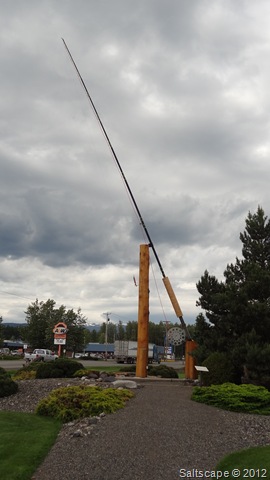Each Friday, I post some relevant (and not-so-relevant) stats about the trip, as well as a little write-up of what it’s like to live out of a van for weeks on end. Here’s where we are overall:
- Total miles driven: 4236
- Total days on the road: 39
- Total miles hiked: 77.3

Fooled you there for a second, didn’t I? This roadside sign fooled us, too. Not to worry, we didn’t include it in the Bear Count.
Here are some interesting stats for this week:
- Fuel stops: 2 (diesel: $3.95 / gallon in Banff, AB; $4.55 in Prince George, BC – prices and units are in US dollars and gallons because we’re ‘Mericans, dammit)
- Technical issues: none (For us anyway, some poor trucker didn’t fare so well -- see the photo down below.)
- National Park Service sites visited: 2 – Banff, Jasper (Canada)
- Elk/Bison/Deer/Sheep sighted: No bison, loads of sheep and deer.
- Moose sighted: 4 (still no males with antlers, though.)
- Bears sighted: 11 (Nearly all of these bears were either feeding by the roadside or literally crossing the road in front of us. Ten were black bears, one a grizzly.)

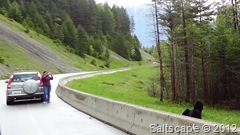
Sometimes it’s more fun to people-watch – especially when they get too close. That short concrete barricade isn’t going to do much to stop those two bears from mauling that lady if they get tired of eating dandelions.
When we were planning this trip, I sat down with a stack of library books and my laptop and did my best to research all the possible routes and cool things to do along the way. As you can imagine, trying to plan out where to go and what to do every day for a five-month trip was an overwhelming task – there’s just so much information to sift through. Plus, I didn’t want to pre-plan
everything – a little spontaneity is a good thing. We want to be flexible in case we decide to stay longer in one place or in case (god forbid!) something serious breaks on the van. So I put together a reasonably detailed plan that got us as far as Jasper. But now that we are past Jasper, we really only have two firm reservations – our Alaska ferry ride next week, and our time in Denali in mid-July. So from here on out all the details are sketchy as to what towns we’ll stay in and how many days we will stay in one place, and what the local attractions are. We are just taking it on a day-by-day basis.

There was a small traffic delay on Highway 16 as workers tried to figure out how to tow this unlucky semi. From what we gathered, he tried to pull over onto a soft shoulder that gave way underneath him and tipped the rig over. Yikes.
Many of the towns on the Yellowhead Highway (Highway 16) are pretty much one-horse quiet little towns with not much going on, so some of the posts this coming week might be a little boring or brief. Up ‘til now most of our posts have been destination-oriented – a national park, or a tourist attraction, etc. – but since there aren’t too many major sights on this part of our route, this week will be more about the journey instead of the destination. We did find out about a cool detour up to one of the smallest towns in Alaska (Hyder, right on the Canadian border), so we’ll actually be briefly setting foot in the Last Frontier state about a week earlier than we’d originally intended. Cool.
One of the things we are trying to avoid is making reservations too far in advance. Like I’ve said, we want to be spontaneous. But we are realizing that some of the more popular places are starting to get crowded now that it is mid-June and everyone is taking their summer vacations. This was the line to check in at Whistler’s campground in Jasper. We didn’t have reservations, and for one of the nights our only choice at this campground was a site with no electric and water hookups. It wasn’t a problem since we had full tanks and full batteries, but it does have me second-guessing our fly-by-the-seat-of-our-pants strategy a little bit.
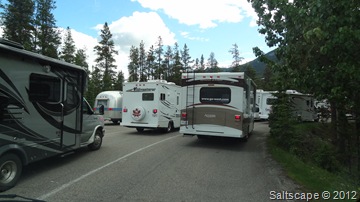
It seems like half the people we run into are Alaska-bound. In a way, it’s similar to when we were cruising and all the other boats were pretty much heading the same direction up or down the island chain depending on the season. One major difference is that you don’t often run into the same people, since there are so many different routes, towns, and campgrounds. With boating, anchorages and routes were a little more limited. Plus you could always listen in on the VHF and if you heard a familiar voice or boat name it made it really easy to keep track of whoever was anchored nearby. CB radio, anyone? Breaker-breaker, any taker – what’s your handle good buddy?
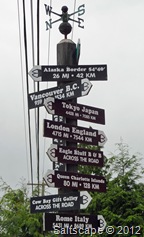 We’ve spent the past two days exploring the Canadian port town of Prince Rupert. The town boasts the deepest ice-free harbor in North America, and is the nearest major North American shipping port to Shanghai, China (a couple of fascinating factoids we learned when we took a tour of the port authority’s visitor center).
We’ve spent the past two days exploring the Canadian port town of Prince Rupert. The town boasts the deepest ice-free harbor in North America, and is the nearest major North American shipping port to Shanghai, China (a couple of fascinating factoids we learned when we took a tour of the port authority’s visitor center). The town was founded in 1910 and many of the buildings from its early days have been preserved. There are lots of pubs and shops near the town docks in an area called Cow Bay – so named because a farmer once had a herd of cows shipped here via barge. All of the trash cans, signposts, etc have a dairy cow theme. Some businesses have taken the cow theme even further, one of the notable cafes is called Cowpuccino’s.
The town was founded in 1910 and many of the buildings from its early days have been preserved. There are lots of pubs and shops near the town docks in an area called Cow Bay – so named because a farmer once had a herd of cows shipped here via barge. All of the trash cans, signposts, etc have a dairy cow theme. Some businesses have taken the cow theme even further, one of the notable cafes is called Cowpuccino’s. Our tour guide was an elderly man who got his first job working here at age 13 or so. He took us around all the buildings and explained the entire canning process for salmon. He was even able to fire up all the assembly line machinery to demonstrate how it worked. In the early days it could take workers up to 20 hours or more to unload, clean, process and can the fish by hand. Once electric machinery was introduced, the work took less than 2 hours.
Our tour guide was an elderly man who got his first job working here at age 13 or so. He took us around all the buildings and explained the entire canning process for salmon. He was even able to fire up all the assembly line machinery to demonstrate how it worked. In the early days it could take workers up to 20 hours or more to unload, clean, process and can the fish by hand. Once electric machinery was introduced, the work took less than 2 hours.


